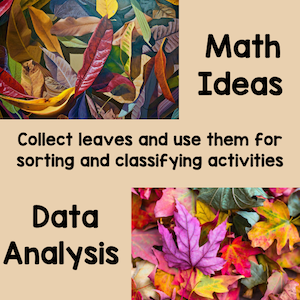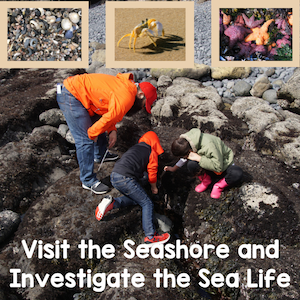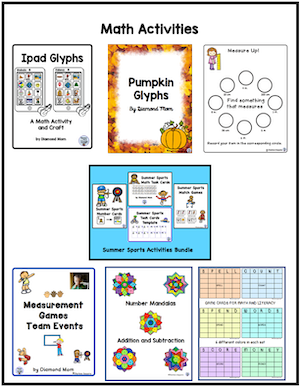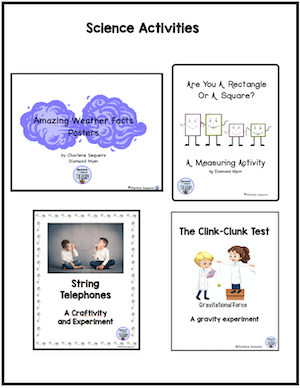Different Physical Abilities In The ClassroomThe ParaOlympics has just taken place over in Tokyo and the Terry Fox Run just happened as well. This reminded me to think about how we can make accommodations for different physical ability issues in our classrooms. Often this is overlooked as we go about our days unaware of the obstacles that children with different physical abilities must face in school. A few years ago, I had a student that broke her leg and she needed to be in a wheelchair for several weeks. This was the first time I made it a point to focus my attention on creating an environment that would accommodate kids with physical disabilities so they could participate in our daily activities. Classroom ArrangementIt is important that we consider the physical arrangement of the classroom, especially if we need to allow for equipment such as a wheelchair to maneuver around the room. Accessibility to materials and equipment also needs to be considered. When I go to the grocery store, there are often things that I cannot reach on the shelves because they are too high, or too far back on the shelves. Imagine how it must feel for those in a wheelchair when they are unable to access things in the classroom for similar reasons. Being in a wheelchair, on crutches, or perhaps wearing a sling or having a cast on an arm or leg makes it more obvious to us that people need help. But, not all disabilities are readily visible and we need to be reminded to consider these as well. Accommodating Kids With Hearing ImpairmentsIn many classrooms nowadays, there are children with hearing impairments. Special equipment is now being used to help these children. Amplifiers, microphones, and hearing aids are provided and teachers and students use this equipment when giving oral instructions or for sharing during conversations and discussions. Not only is this helping the hearing impaired child, but it is taking some of the strain off of the voice of the teacher who is speaking to be heard in a classroom and it is helping others to hear better as well. Using closed captions or a transcript program when required to follow a movie, videoclip, or presentation would be helpful so they can have the added support of reading when things might be difficult to hear. Learning and teaching sign language would also be helpful if they use sign language. Even if it was only the basics, it could still help with communicating. Accommodations For Visually Impaired Students Visually impaired students also need some changes to make their learning successful. It is amazing how much they are capable of doing if given the right environment. The degree of impairment also needs to be considered. Some students may be able to partially see and may just need to have larger fonts, less clutter, and brighter, clearer colors to function successfully. Others may have more severe visual impairment or even be completely without sight. They would need more accommodations to make learning successful. This could be audio recordings of any written material or transcripts in braille. Having a buddy to help guide them when maneuvering around the classroom until they become familiar with where everything is would definitely be useful. It is important that the classroom arrangement stay the same unless the student is prepared and shown when things have been moved around to avoid a dangerous situation. Some students may need to use a cane to help with getting around as well. Helping Others To Understand The DifficultiesIf we want to help those who have different abilities to participate fully, it sometimes takes some understanding of the difficulties they experience to fully get what to do. When my student had to be in the wheelchair, I decided to create some scenarios to help the other students to understand some of the difficulties. We also came up with some solutions together to make things work. I then went further and we talked about some of the accommodations that might be needed to help someone who was blind, or who had a broken arm, who was on crutches, etc. We did some role playing and set up situations where students had to become the person with the ability issue. I brought in a wheelchair and crutches, we blindfolded students, and we used slings for a broken arm. Kids took turns being the one with the ability issue and the others found ways to help them with various situations. This gave them a bit of an understanding of what it might be like for the person with an ability issue. Following these activities, the students were able to think ahead and make sure that my student in the wheelchair had the necessary help and they worked together to make sure she was able to participate fully in all activities. After doing the role playing, they also found solutions to other situations I gave them a reflection sheet to fill out. It was interesting to see how it changed their thinking and how much more aware they were of others and their needs. There are many other situations and scenarios, but I hope you get the idea. If we want to make accommodations that work for everyone, it is necessary for all the students to work together. This requires understanding the situation and creating solutions together. Working Together To Create SolutionsI have created an activity booklet that focuses on some of the different physical abilities that need accommodations as simple scenarios that require discussion and possible solutions. Hopefully this will help make all of us more aware of things we can do to make learning successful for everyone. You can find it here in my TPT store. I am giving a sampler booklet to my subscribers. Get your free booklet now. These are just a few tips or suggestions to help make it easier for accommodating different physical abilities in the classroom. I am sure there are so many more ways we can make things work better. I would love to hear some of the ways that you have made accommodations in your classroom.
0 Comments
Fall Is Almost HereFall is around the corner. I don't know about you, but we had a beautiful summer. Some days it was a little hotter than we liked, but for the most part, we couldn't have asked for better weather. It was a great time to get outdoors and enjoy nature. Now that fall is arriving, this doesn't have to end. There is still time to get outdoors and do things before the weather gets too cold or wet. This is also a great time to focus on nature and science in the classroom using the outdoors as your source for material and data. There are also many opportunities for math and literacy activities. Fall leavesFall colors are so beautiful. Driving along the streets, the different colored leaves create a wonderful backdrop. Kids love to explore the different kinds of leaves and collect them as they begin to fall off of the trees. There are many different activities that can be done with the leaves such as math activities, science activities, writing activities, and art activities. You can use the colors and shapes for creating art projects, do sorting and classifying activities in math, investigate how the colors change and why as a science activity, or maybe use the collecting of the leaves as a story prompt. These are only a few ideas. Get creative. Beach StudyBeach walks can still be done in the fall, and different activities can be included that explore the sea life there. It is always fun to watch the kids explore the seashore and search for the different sea animals and plants there. They can be found in the tide pools collecting shells, crabs, seaweed, and other things for scavenger hunts. The sea stars and sea cucumbers are always a big hit as well. I remember taking along lots of magnifying glasses so they could get a closer look at the different things they found. Note: We were careful about handling the sea life and we made sure that we were able to return them back to their environment safely. We always put everything back before we left. It is important to leave the sea creatures in their environment. Exploring Parks And ForestsGoing for walks in the parks and forested areas can also be fun to do in the fall. Taking a look at how things might have changed during the different seasons, what different animals might be around, what different plant life looks like, checking out the streams or creeks, etc. are just some of the possible things that can be investigated. Geocaching is also a fun activity to do. It is difficult to do with a large group because it is supposed to be stealthy and not attract attention, but it still can be done in certain settings. A modified scavenger hunt could also be done that mimicks geocaching but is set up for a specific group instead of the public. Farm VisitsMost people think about planting seeds in the spring and watching them grow throughout the summer, but there are also many things that can be planted for the fall. Checking out some of the fall harvests and taking a field trip to a pumpkin patch or farm could also be fun to do. Perhaps some plant investigations can be done now and even compared with plant investigations in the spring. This is only a sampling of things that can be done in the fall that get kids outdoors. The key is to find ways to keep them actively exploring and learning both inside and outside the classroom. The more connections to real life, the richer the learning will be. I hope you find some of these ideas helpful for your students. I would love to hear about some of the things you do outdoors with you class. Let me know in the comments. Related PostsMarathon Of HopeTerry Fox's Marathon Of Hope has been happening for over 40 years now. I still remember when we were shown a movie of his journey. He wanted to go across Canada to raise money. His goal was to raise $1.00 for every Canadian. He ran the equivalent of one marathon each day. It is hard to imagine running a marathon every day with two good legs, let alone with one good leg and an artificial leg. Most people would train for months to do one marathon. That movie really made an impact on me. Terry Fox was around my age and he had his life cut short because of cancer. He didn't feel sorry for himself, but instead put his effort into making a difference. He started the Marathon Of Hope in 1980 and Canadians have been continuing this marathon every year. I remember when it became a yearly event here in our city and our family participated in either the community run or the run with our schools. It is hard to believe that it has been 41 years since he first dipped his foot in the Atlantic Ocean and started his marathon of hope. Terry Fox: A Canadian HeroTerry Fox is a Canadian hero because he didn't think about himself and feel sorry for himself when he lost his leg. Instead, he decided to help others by raising money for cancer research. He endured pain and suffering for 143 days as he ran across Eastern Canada striving to make a difference. Some days were better than others, but no matter how difficult it got, he didn't give up. He had days when he saw very few people and raised very little money, and he had days where crowds came out to run alongside him and volunteers were needed to help gather up the donations. When Terry had to stop due to cancer in his lungs, he still wanted to make a difference. He said, "Even though I'm not running anymore, we still have to try to find a cure for cancer. Other people should go ahead and try to do their own thing now." His Legacy ContinuesThe Terry Fox Run was established in 1981 to continue Terry's Marathon of Hope. September 13th was designated as Terry Fox Marathon of Hope Day. Every September different communities held a Terry Fox run. Schools would choose a day in late September to do a school run for Terry Fox. Whenever we did a Terry Fox run at the school, time was spent telling Terry's story and sharing stories about how cancer has affected many people that we know. It is frightening to think that almost every family has been affected by cancer in some way. After sharing the stories, we chose people to run on behalf of. Posters were made and feet were posted along the hallways to show how we were in this together, even if it was only for one day a year. I created some activities and posters for my students. They are available here. Hopefully they will inspire kids to do something that makes a difference just as Terry did. I hope that you will be inspired to participate in the Terry Fox Run in your area and that you will help others to continue to share Terry's dream and keep it alive. Let's all work together to help stop cancer. For free resources, tips, and ideas, sign up for my newsletter. Related PostsGetting back into the swing of thingsSummer break is over. School is back in session! For some, you have already been in session for a few weeks. For others, this is your last weekend of break. The question on many teachers' minds is "What will this year bring?" Some kids are excited, some are anxious, some are disinterested, and some are unhappy. There are so many emotions during the regular return to school, but with the uncertainty and constant changes last year as we navigated through the unknowns of the pandemic, some emotions escalated. Many kids experienced more anxiety, confusion, and frustration as they tried to learn in new environments and situations, many parents experienced anxiety and frustration as they navigated online and at home instruction, and teachers experienced anxiety, uncertainty, frustration, and burnout as they tried to balance in person, online, and hybrid teaching situations. There was hope that we would be closer to a more normal school year, but things are still changing and we need to be ready to change gears at any moment. This uncertainty is causing teachers stress even before school begins. Many of my teacher friends are still waiting to find out what grade level they are teaching, how many students they will have, and even where they will be teaching. Primary teachers ready to go kitIt is important to have some things ready for any situation to help get through the transitions of the first weeks. You might call it a survival kit. This kit would need activities for various grades, subjects, and configurations of students. The question is, what should be in this kit? Here are some ideas for primary grades. (Some could be modified for intermediate classes, but since most of my teaching was in primary, I have decided to focus on that level for this sample.) Literacy ideas that are ready to goHere are some literacy activities that will engage and provide reading and writing practice for your students. Selections are from various free and paid products. The full products are listed below. Refreshing Idioms Task Cards (sample from the full product) 5 Senses Stories Story Board Fun (activity from Back To School Math And Literacy Ideas) Summer Parts Of Speech (one set of cards from the package) Fall/Autumn Parts Of Speech (one set of cards from the package) Find The Evidence (sample pages) Soundo (part of Alphabet Game Boards) Vocabulary Mandalas (one mandala) Basic Vocabulary Activities ( activities from the product) Quick and fun math activitiesHere are some fun math activities to help your students work on basic math skills. Selections are from various free and paid products. The full products are listed below. Ipad Glyphs (sample from the full product) Pumpkin Glyphs (sample from the full product) Measure Up! (activity from Welcome Back To School) Summer Sports Activity Bundle (activity from the bundle) Measurement Games Team Events ( one event from the games) Number Mandalas Addition and Subtraction ( one of the mandalas) Literacy and Math Game Cards (2 game cards) Science fun and experimentsThese science activities will keep kids entertained while learning about science facts. Selections are from various free and paid products. The full products are listed below. Amazing Weather Facts Posters (freebie) Are You A Rectangle Or A Square (freebie) String Telephones The Clink-Clunk Test Team building activitiesTeam building is important at the beginning of the year, but also throughout the year. Here are some activities that can be done in groups or with partners. Back to School Ice Breaker (freebie) Escape Room What Am I? Vocabulary activity (one activity from the set) Find Someone Who (activity from Back To School First Week Activities) Stumpers (activity from Back To School First Week Activities) What Am I? (sample pages from What Am I?) Self esteem activitiesMaking sure that children understand that they are valuable and important will help to develop positive self esteem. Here are some activities that will help with this. Paying It Forward (freebie) Optimist or Pessimist Task Cards (one set of cards) Goal Setting And Reflections (freebie) Brain breaks and active gamesHere are some active classroom games that can be played as brain breaks or in the gym or outside to provide movement and stimulation between other subject activities. Each of these areas is available as a separate package, or you can get the whole bundle to keep on hand for activities to use throughout the year. It will be helpful when you need to prepare for substitute teacher on short notice or if you just need a quick activity to use. You can find the kit here. As I indicated, this is just a sample of some of the things that could be done. It will be up to you to add your own creativity, experience, and preference to your ready to go kit. For more ideas and resources, you can check out the various categories in my TeachersPayTeachers store. If you are looking for back to school resources, you can check out my recent blog post for resources and tips. I wish you all the best as you venture into a new school year. Note: This resource has been updated and more resources have been added to it. For free resources, tips, and ideas, sign up for my newsletter.
|
About Me Charlene Sequeira
I am a wife, mother of 4, grandmother of 9, and a retired primary and music teacher. I love working with kids and continue to volunteer at school and teach ukulele. Categories
All
|















































 RSS Feed
RSS Feed